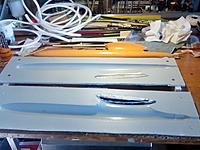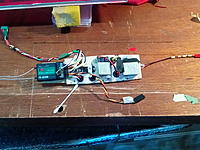Comments (0)
Add Comment
-
 Views: 251
Views: 251
This craft will fly under the name Endorphin, which was the name of my first successful sloper. Now retired. -
 Views: 260
Views: 260
Level and plumb bob on the bench to tail set up. -
 Views: 272
Views: 272
Mould for the fuselage pod with spacers to facilitate release of the part. -
 Views: 288
Views: 288
Servo tray with elevator, rudder and aerotow release servos. Fly Sky 10 channel receiver with alt sensor and vario. -
 Views: 258
Views: 258
Underside of the try showing LM1084 5.8 volt 5A regulator for 2 x 18650 LiIon cells and MosFet switch. -
 Views: 271
Views: 271
Plug for the fuse pod and part fitted with carbon boom.
-
Views: 183
6mm x 6mm Pauwlonia framing and 3 mm aircraft grade ply. Polyurethane glue. -
Views: 179
16 mm blue foam blanks hot melt glue fixed to a flat building board. Simple 3 mm MDF templates; CA treated edges then sanded. Works ok. Here, the top cut has been done with the hot wire. -
Views: 178
A pilot hole was first made with a heated metal rod. Then the hot wire was threaded through. Both ends held outside the wire clips, power applied and the hole cut by rotating the ends slowly. -
Views: 207
2 mm carbon strip TE. Pauwlonia strips and more ply. Gudgeon and pintle hinges fitted using a 2 mm carbon rod as the pintle. The half roll nose on the control surfaces were made with 2 layers of 100 gsm glass fabric on a tube then split in half. -
Views: 49
A nose cone/motor cowl has since been added.
-
Views: 385
The top cut has been done here. The tapered hole for the spar can be seen. -
Views: 365
Ready to glue in main composite spar. Polyurethane glue to the rescue here! -
Views: 380
I made up a little carbon fibre joiner that fitted the root ends of the tapered carbon spars nicely. All composite parts were post cured at 45 C before installation. -
Views: 411
Ready for paint. Test flown yesterday. Fantastic flyer!
-
Views: 435
These are the 14 mm blue foam blanks that will form the ribs. The control surface "Warren Truss" ribs are scrap depron. -
Views: 452
I used timber spacers to lift the foam strips up to height. Blue foam trailing edge. -
Views: 459
Top cut done. See video. -
Views: 478
The main spar core and shear webs are just sitting in place. They will be removed and fitted with uni-carbon spar caps when the rain stops. Too humid!
-
 Views: 500
Views: 500
My first rough "breadboard" style assembly, just to get the device working. Vario on the left and receiver on the right. -
 Views: 503
Views: 503
Wiring onto the Arduino nano pins. Requires magnifying lens or glasses. -
 Views: 509
Views: 509
Final vario. Read for heat shrink. -
 Views: 542
Views: 542
Vario in the foreground; just needs some hot melt glue on the wires where they exit the heat shrink. This will prevent fatigue. The servo box in the back ground contains the 433kz receiver, single cell LiIon. Wires ready for a ear plug socket. In the mail
-
Views: 649
The wing support arms will articulate backwards only. Theoretically, this allows the plane to be pitched up and not down. Back wheel is articulated. -
Views: 683
My foam Phoenix 2000 will be flown to test it out first. -
Views: 689
Slight pitch adjustment will be provided by raising the front of the dolly with some packing between the axel and the ply base.






